This article is taken from First Five of Contra Costa. http://www.first5coco.org
Article written by: Rona Renner, RN & Marisol Muñoz-Kiehne, PhD
Traumatic events take many forms. Unfortunately many people have experienced events such as fires, earthquakes, hurricanes, floods, accidents, illnesses, death of a loved one, divorce, and violent acts. Currently, at this time in our country, things are changing fast, and some of the policies and actions from the new administration are causing fear, confusion, suffering, and anxiety in our country and throughout the world. Protests and marches are happening on a daily basis, and for many there is a sense that each day will bring something new to face.
As adults we need to be prepared to handle our reactions to events so we can be there for the children who count on us to protect them and guide them.
Suggestions to consider:
- Be aware of your emotional state and respond to a child in a calm, thoughtful, and honest manner. Remember that children can hear you when you’re on your phone. You may have a worried look on your face, you may feel angry, or you may be crying. As soon as you can, focus on what your child needs, and let your voice, gestures, and body language be reassuring.
- Children want to know that they will be safe. They need to see that the adults are in charge and that they are doing all that they can to ensure safety. ‣ Tell them what kinds of things you do to keep them safe. Talk to them about the people in their family, school, and community who are helpers and who they can count on when things are confusing or scary.
- Always find out what a child already knows and keep your explanations simple. Give information that will clarify facts and reassure your child.
- You may need to start by correcting misinformation.
- Give children information at their level and be truthful.
- If you have a young child you can shield them from the events that are happening. Remember though, that young children pick up on adult’s fears and concerns even if they don’t know the details of what is going on.
- Even if you have shielded children at home, they will hear all kinds of things from other children in childcare or school.
- Listen to what the children are telling each other. Ask them what they have heard at school about the event or issue.
- Find ways to use the current situation to discuss things that might occur in school. For example if you ask an 8 year old, “What have you heard about the President?” A response may be “I heard he was a bully.” You can then ask if your child has had any experiences with bullies at school? From there you can discuss why someone may be a bully and what to do about that.
- Help your child understand that people have different opinions of the people in our government. As he gets older he can learn more about how our government works, and the values he would like to see in our leaders.
- If you focus on family values, you can use the discussion as a way to strengthen some values such as kindness, compassion, fairness, and gratitude. Don’t be surprised if your child has a point of view that is different from yours.
- Turn the TV off. Young children do not benefit from seeing the dramatic images of a disaster or people who are frightened or angry. If children see frightening images on TV, tune into their feelings. You may need to give them help in articulating what they saw and how they felt.
- Over time — keep your investigative cap on. Children may be hearing scary things from neighbors, relatives, or friends.
- Talk with parents and teachers about who is talking about what.
- Observe children’s play, listen to what they are saying, and provide extra comfort. Acknowledge their feelings and your own. For example you can tell a child that you were scared when you saw the fire truck at the house.
- Some children will act out what they saw. For example a child may build a building with blocks and then crash it to the ground over and over again. If they are not hurting themselves or others, let them use play to work out their concerns. You may need to set limits and use distraction if a child needs to move on.
- People feel a loss of control when there is a disaster or violent event, or even a fear of one. Think of things that you and your children can do to increase a sense of agency.
- You can draw pictures or posters, write a letter, collect money, send a package, plant flowers, join a march, bring food to someone in need.
- Stay connected. Read stories based on your values. For older children, help them with actions that are fitting to their age and ability.
- Consider a child’s age and developmental stage. ‣ If a child is under two, you don’t have the advantage of language skills for communication. Babies may be fussy due to sensitivity to the adults around them, or there could be a change in eating or sleeping patterns. Babies needs a sense of security and routine. Hold them more. Playing with a baby can also help you relax.
- If a child is 3-5 years old you have the advantage of language and verbal communication. Listen to a child’s questions and try to answer what they ask without giving more information than needed. Don’t be surprised if a child wants you to repeat the answer 2 many times. Use different modes of communication, for example tell or read stories, draw pictures, play games, role play with puppets or dolls.
- You can set up a number scale with children where (10) is when they have felt the happiest and had a great day and (0) is when they have felt the worst ever and had a terrible day. This is a way to check in with them to see what kind of day they are having. Ask them what they could do to change their day to a higher number.
- Consider a child’s temperament. A person’s behavioral style will influence how they respond to challenging events.
- Children who are intense are likely to have strong reactions to what they experience and feel. They may have tantrums, cry more, talk more, or be more demanding of attention. Help them express their feelings in a constructive way.
- Children who are sensitive may pick up on parental feelings or expressions easily, or may be bothered by the noise level if it’s higher than usual.
- When children are withdrawing or slow to warm up they may stand back and not ask questions or express their feelings. They may have more trouble separating from a parent. Check in with them.
- High energy children may get more active than usual when upset or anxious and have trouble sitting still or playing quietly. “Bouncing off the walls,” can be one way for them to express concerns. Help them find other ways. ‣ Some children are slow to adapt to change and may dig in their heals when the routine is not as usual. Dawdling, or refusing to follow instructions is common. ‣ To get more information on temperament you can do a profile on a child (4mo-5yrs) at http://www.preventiveoz.org.
- Stay aware of children who have experienced a traumatic event in the past, such as children whose parents or relative has died, a child who has had an operation, or children who have suffered from abuse, neglect, or other violence. These children are more susceptible to strong feelings or Post Traumatic Stress Disorder (PTSD).
- Deal generously with your own feelings and needs. If you are overwhelmed by your reactions find another adult to talk to or seek counseling. Take time to renew your energy and do your best to get enough sleep. Your children are watching you.
Permalink
|
0 Comments
 Reading aloud to your child establishes a wonderful bedtime routine. It has the benefit of improving language (both understanding of language and use of language), encouraging attention, providing a calm, quiet way to wind down before bed, and encourages a lifelong love of reading. Try having your child choose a book to read before bedtime. You can offer a choice of two and allow him or her to make a choice by pointing, reaching, or verbally telling you.
Reading aloud to your child establishes a wonderful bedtime routine. It has the benefit of improving language (both understanding of language and use of language), encouraging attention, providing a calm, quiet way to wind down before bed, and encourages a lifelong love of reading. Try having your child choose a book to read before bedtime. You can offer a choice of two and allow him or her to make a choice by pointing, reaching, or verbally telling you.
If your child isn’t ready to listen to all the words, you can just name the pictures, have your child name the pictures, point to familiar things, and talk about what you see. It’s a great time to emphasize vocabulary, including nouns and action words. Make reading interactive by including your child in the activity, even if it’s just turning the pages.
Also, as things get busier and busier around this time, don’t forget that not all attempts to communicate are made verbally. If your child hands you a toy, points to an object, or leads you to something that he or she wants, that is communication! These non-verbal communications can be reinforced with a verbal description of what your child is really trying to say (e.g., “Oh, you want me to play,” “Yes, I see the plane,” and “You want juice”). Give your child the opportunity to hear the words associated with these communicative efforts.
Activities to try at home:
- Put teddy bears to bed
- Establish a bedtime routine with imitation of gestures (e.g., yawning, blowing kisses, putting your finger to your lips and saying “shhh”)
- Talk about your morning routine of waking up, eating breakfast, brushing teeth, going to school, etc.
- Give dolls/favorite toys a bath before putting them to bed and then wake them up
- Look at the sky and talk about the sun, moon and stars. Label that daytime is light and nighttime is dark.

Snowman’s Nose Poem
A little, white snowman
Had a [carrot] nose
Along came a [bunny],
And what do you suppose?
The hungry little [bunny],
Looking for it’s lunch,
Ate the snowman’s [carrot] nose –
Nibble, nibble, crunch!!
Recommended books:
Goodnight Moon by Margaret Wise Brown Goodnight Gorilla by Peggy Rathmann
The Napping House by Lois Ehlert Goodnight, Goodnight Construction Site
A Book of Sleep by Il Sung Na by Sherri Duskey Rinker
Permalink
|
0 Comments

Monthly Theme… Winter Holidays
Concepts… hi/bye, in/out
Sounds… W, Long I (hi, bye)
This month’s theme is a great time to establish a few easy routines or traditions in your home. Routines are activities that children can predict, remember, and participate in easily over time, because these activities are repeated regularly and the children learn what to expect! It can be something as simple as having your child help set the table each night, choose a book before bedtime each night, or sing a song as you wake him or her up each morning. Routines are great because you can review the same vocabulary over and over, and it allows the child to feel successful. Remember that to learn new words, kids need to have lots and lots of exposure to those words and opportunity to practice them in a meaningful context.
This is a great opportunity for the children to share about their families. If you have some extra copies of family pictures, it would be great for the children to bring them in and share them with their peers at school. While children may remember fun and exciting things that happened at home, they do not yet have all of the language that helps them share about it here at school. Pictures are a great way to help them be able to make connections between home and school.
Activities to try at home:
- Take out photo albums and point to and name familiar family members and friends
- Try new foods of different cultures and talk about tastes, colors and textures (“It’s yummy!”, “The ___ is red”, “It is crunchy!”) Label actions while cooking (e.g. pouring, stirring, mashing).
- Play a “Where is ___?” game using all of the members of your family (“Where is Daddy?” “Where is Mommy?” “Where is your brother?”) and have your child point to each member of the family as he or she is named
Book Recommendations:
Fa La La by Leslie Patricelli My First Kwanzaa by Karen Katz
Hanukkah: A Counting Book by Emily Sper That’s Not My Reindeer by Usborne Books
Very First Words Christmas by Usborne Books The Polar Express by Chris Van Allsburg
Permalink
|
0 Comments
It is holiday season and soon children will be on winter break. Below are some fun activities.
The Amazing Bubble Show at Rhythmix. A blend of comedy and artistry for the whole family. December 11. https://www.rhythmix.org/events/bubble-show-dec2016.html
Fancy Nancy Splendiferous Christmas (based on the book of the same name) at the Berkeley Children’s Theater. http://bactheatre.org/shows/FancyNancyChristmas
Kids’ Night Out! Parent’s Night Off! The Oakland Zoo has an amazing opportunity on select Saturday evening throughout the year. Pre-registration required — http://www.oaklandzoo.org/ or contact education reserevations@oaklandzoo.org.
Fairyland is located in Oakland by Lake Merritt. Since 1950, Children’s Fairyland has delighted children and their parents with whimsical storybook sets, gentle rides, and more. http://www.fairyland.org/
Pixieland – Concord. Whimsical amusement park with a range of carnival rides for young kids. http://www.pixieland.com/
FUN AT HOME – check out these two blogs for some fun activities.
- picklebums.com
- toddlerapproved.com
Permalink
|
0 Comments
Concepts … loud/quite, up/down
Sounds … H, Short A (apple, happy)
Children first begin to develop awareness of their emotions, and as they mature, they begin to learn how to self-regulate their emotions. When your child is angry, you can label his or her emotions (e.g. “You’re showing me that you are mad”).  Or if you are playing in the park, and another child is crying, you can label it for your child (e.g. “Look, she is crying. She feels sad”). You can also point out what his or her face is doing (e.g. “You’re feeling happy, because you are smiling and laughing”).
Or if you are playing in the park, and another child is crying, you can label it for your child (e.g. “Look, she is crying. She feels sad”). You can also point out what his or her face is doing (e.g. “You’re feeling happy, because you are smiling and laughing”).
Teach “Turn-taking” Rather Than “Sharing”
Around 18-24 months, children begin to share toys with their peers, and they may even extend a toy or object to another peer. This is a foundational skill for initiating play, which takes place between 24-36 months. Children must first have ownership of items before they can begin to participate in sharing. As play skills continue to develop, children begin play by offering a toy or using words to join an activity/interaction. These behaviors can be encouraged at home when playing with siblings or friends.
Use phrases and hand gestures such as patting your child’s chest and modeling “Ben’s turn”. After a short period, model something like “Ball is all done” or “Your turn is all done” and then facilitate turn-taking by patting a sibling for friend’s chest and saying “Now it’s Jesse’s turn”, etc. Pat your own chest and say “My turn” when asking your child to give the item to you.
Activities:
- Identify the emotions of characters in books that you are reading. Label only the basic emotions at this stage (e.g. happy, sad, mad, and tired). As your child masters these, you can move onto more complex emotions (surprised, scared, etc.).
- Make facial expressions and silly faces in a mirror and talk about what they look like.
- Label your own emotions for your child.
- Sing “If You’re Happy and You Know It”.
- If you’re happy and you know it clap your hands; if you’re sad and you know it wipe your tears; if you’re angry and you know it stomp your feet.
Emotion Book Recommendations:
When You’re Mad and You Know It by Elizabeth Cray, Shari Steelsmith, Mits Katayama
Today I Feel Silly by Jamie Lee Curtis
How Are You Peeling? by Saxton Freymann, Joost Elffers
The Way I Feel by Janan Cain
Glad Monster, Sad Monster by Ed Emberley, Anne Miranda
Permalink
|
0 Comments
The following post is from http://www.speech-language-development.com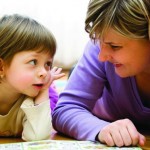
Kids who are just learning to speak don’t feel secure with their ability to express themselves. When an adult in their life starts showing them pictures and asking them questions like What’s this?, What’s he doing?, and What’s going to happen?, kids often shut down and refuse to talk, much to the frustration of the adult involved.
Questions aren’t really therapeutic for language development. If you want to get a young child to talk to you, a much more effective way is to pay attention to something that the child is interested in at the moment, and you verbally express interest in it. This may change from moment to moment, so, as always, you have to follow the child’s lead.
Careful use of “I wonder” statements can be very effective in encouraging your child’s curiosity and anticipation. Holding a ball or toy car at the top of a ramp and saying, “I wonder how far it will go” invites your child to make a prediction without putting him or her on the spot. Whether or not he or she says anything, you can then say, “let’s see,” and release the object, then comment (enthusiastically) on how far it went.
One word of caution, however: it is easy to fall into the traps of simply using “I wonder” statements as an alternative way to ask questions, as in, “I wonder what you are doing, Jenna?”, followed by a pause during which you look at the child with that ‘okay, now you need to answer me’ look on your face. Be sure that your non-verbal messages – eye gaze, posture, tone of voice, etc. – clearly communicates that you are just ‘thinking aloud,’ and the child is welcome but not expected to reply.
Permalink
|
0 Comments
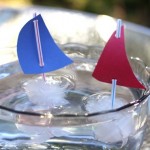 Concepts … wet/dry, hot/col
Concepts … wet/dry, hot/col
Sounds … W, Long I (dry, sky)
Activities:
- Talk about staying cool in the heat while going to the swimming pool or beach, taking a bath, washing the car, or drinking cold water.
- Read One Fish, Two Fish, Red Fish, Blue Fish, Finding Nemo or The Rainbow Fish. Talk about the animals and fish that live in the water.
- Sing “Slippery Fish,” “Five Green and Speckled Frogs,” or Row, Row, Row Your Boat.”
- Give dolls or favorite animals a bubble bath, and talk about washing them and taking them in and out of the bath, and making them wet and dry.
- Drive toy cars and trucks through a “car wash,” by spaying them with spray bottles, washing them with sponges, and talking about making them wet and dry.
- Label the things you see while at the beach (e.g., crabs, shells, fish, water, sand, waves) and talk about whether the water is hot or cold.
Water Play Ideas:
Set a big plastic container filled with water outside and place with any of the following:
- Small plastic fish, ducks or other animals.
- Dolls for bathing.
- Sponges and wash cloths.
- Paint brushes for “painting” the sidewalk.
- Cars for washing.
- Boats or make your own Ice Cube Boats. Make ice in a plastic cup set with drinking straw and a flag for a sail. Perfect for hot days.
- Plastic cups, funnels, and strainers for pouring and filling.
- A watering can for watering plants.
Summer Book Ideas:
All You Need for a Beach by Alice Schertle Sea, Sand, Me! By Patricia Hubble
It’s Summer by Linda Glaser Commotion in the Ocean by Giles Andrae
Beach Day by Karen Roosa Over in the Ocean by Marianne Berkes
Permalink
|
0 Comments
In our last few postings, we have focused on activities that enhance your child’s motor skills. Our next few articles will be about developing your child’s speech and vocabulary. We Care’s speech pathologist plans themes for the classrooms and we will be sharing these with you.
Transportation Theme
Concepts … stop/go, fast/slow
Sounds … T, Long O (go, slow)
Talking about what you see and what you’re doing is very important to help develop a child’s language. Providing a simple narrative throughout their experiences helps children associate words with the actions and things. Let them hear you use lots of simple verbs and labels during the day. Children learn best through lots of exposure to the same information. Repetition is key; that is why they never get tired of the same stories, songs, and toys
Activities:
- Use floating boats in the bathtub and talk about whether they are moving fast or slow.
- Make a “car” out of a shoe box. Put toy people or animals in it and make it stop and go.
- Pretend that you are police cars or fire trucks. Make loud siren sounds! Let your child choose whether to “drive” fast or slow. Make red stop signs and green traffic light signs.
- Let your child help wash the car and talk about moving the sponge fast or slow.
- Take some dump trucks to the park. Fill them with sand or dirt and pour it out quickly and slowly.
- While getting in the car, talk about what you are doing (e.g., “First we open the door, then we sit down, and last we buckle our car seat”).
Sorting Activities: 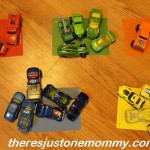
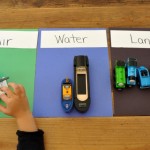
- Collect transportation toys (boats, cars, trucks, buses, airplanes, helicopters, etc.) or use magazines/catalogs to find a variety of transportation items. Set up sorting by color by putting pieces of paper in each color of the item so that your child has something to match the item with. You can also sort by type of transportation: air (sky), water, and land (street) and make labels to put on paper for the items to be placed upon. This is also a good activity to work on the sounds each item makes (e.g., engine, horn, etc.) as well as their parts (e.g., wheels, doors, windows, wipers, lights, and horn).
Transportation Book Recommendations:
The Goodnight Train by June Sobel Go! Go! Go! Stop! By Charise Mericle Harper
Freight Train by Donald Crews Sheep in a Jeep by Nancy Shaw
Go, Dog, Go! by P. D. Eastman Duck on a Bike by David Shannon
Permalink
|
0 Comments
Visual perceptual skills include what we see and how we understand what we see. Perceptual processing helps us organize our sensory information into meaningful patterns. It helps us recognize and identify shapes, colors, size, and relationships between objects. For instance, learning “depth perception” helps us go up and down stairs and learning “figure ground” helps us find an object in a crowded background (like in a ‘junk drawer’).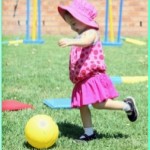
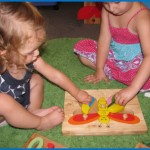
Activities for your child to do to promote perceptual visual motor skills:
Outside
- Going down a small curb or small stairs helps with judging depth perception.
- Walking on a wide line on the ground or a wide beam that is on the ground helps to judge staying on a line.
- Step in and out of shallow containers such as a small wading pool, over lines on the ground or a hula hoop, helps develop spatial awareness.
- Playing ‘kick the can’ (or balls or balloons) develops visual tracking and where to place your body in order to kick the object.
- Throwing objects at a target or into a container (box, laundry basket, etc.) helps to judge distances and how hard and how far to throw the object.
- Hang a beach ball from a string and practice hitting it with a foam ‘noodle’ (like the ones used in the pool). You can cut the ‘noodle’ in half if needed to make it smaller.
Inside
- Put pan or jar lids on and take them off. This helps children judge where to put things to make them fit. Put objects inside of each other (nesting) – like plastic mixing bowls.
- Draw “roads” on large paper then use a pencil to draw on a road or have your child use a little car drive on the road while staying on the road.
- Stack objects such as jello boxes, shoe boxes, etc. The fun part is to knocking them down!
- Using a container with a ‘fit-on-lid’, cut a slot in the lid to fit discs (like poker chips in the slot), then have your child put them in the slot horizontally. When they are able to do that, gradually turn the slot each time until it eventually is vertical to your child.
- Puzzles – for shape puzzles, start with a circle. When you child can put in a circle independently, then go to the square and then the triangle.
- Stringing objects is very good for hand-eye skills. If your child is just learning this skill, use a wooden spoon and large rings like shower curtain rings or rings cut from a paper towel tube. Start with the spoon in a vertical position. When your child is successful with that turn the spoon to a horizontal position. Then you can use stiff tubing (like aquarium tubing) and then stiff cord. Gradually make the beads smaller and then try a stiff boot lace or shoe lace.
Interesting fact:
There is a correlation between gross motor skills and language skills.
One aspect is that the more mobile your child is and the more they explore their world, the more opportunities and the more desire they have to tell you about their world.
Permalink
|
0 Comments

Gross Motor
- Crumple up paper into a ball and throw it into a laundry basket or wastebasket.
- Fill several 2-liter bottles with water, glue the lid on and then log roll on the floor to knock them down (or knock down a stack of empty shoe boxes).
- Practice jumping by holding onto a chair or solid object or jump on an old couch cushion.
- Use blue painter’s tape to make shapes on the floor/carpet. Hop in and out of the shapes, walk or hop on the lines, or wheel barrow walk on the lines.
Fine Motor
- Cut rings from an empty paper towel roll and practice ‘bead stringing’ by putting them on a wooden spoon handle.
- Use straws that are cut to different lengths and practice putting them in the shaker side of an empty Parmesan cheese container. Other small items can be put into the ‘pour’ side of the lid.
- Use ice tongs or sugar cube tongs to pick up small items such as pom poms, cotton balls, or small pieces of paper rolled into balls.
- Use a small, empty water bottles and practice pincher grasp by putting raisins or cheerios or beads in it.
- Practice oral strengthening by blowing a variety of light items off the table or into a cup turned on its side. Craft pom poms, cotton balls, and small pieces of paper rolled into balls work well.
Permalink
|
0 Comments




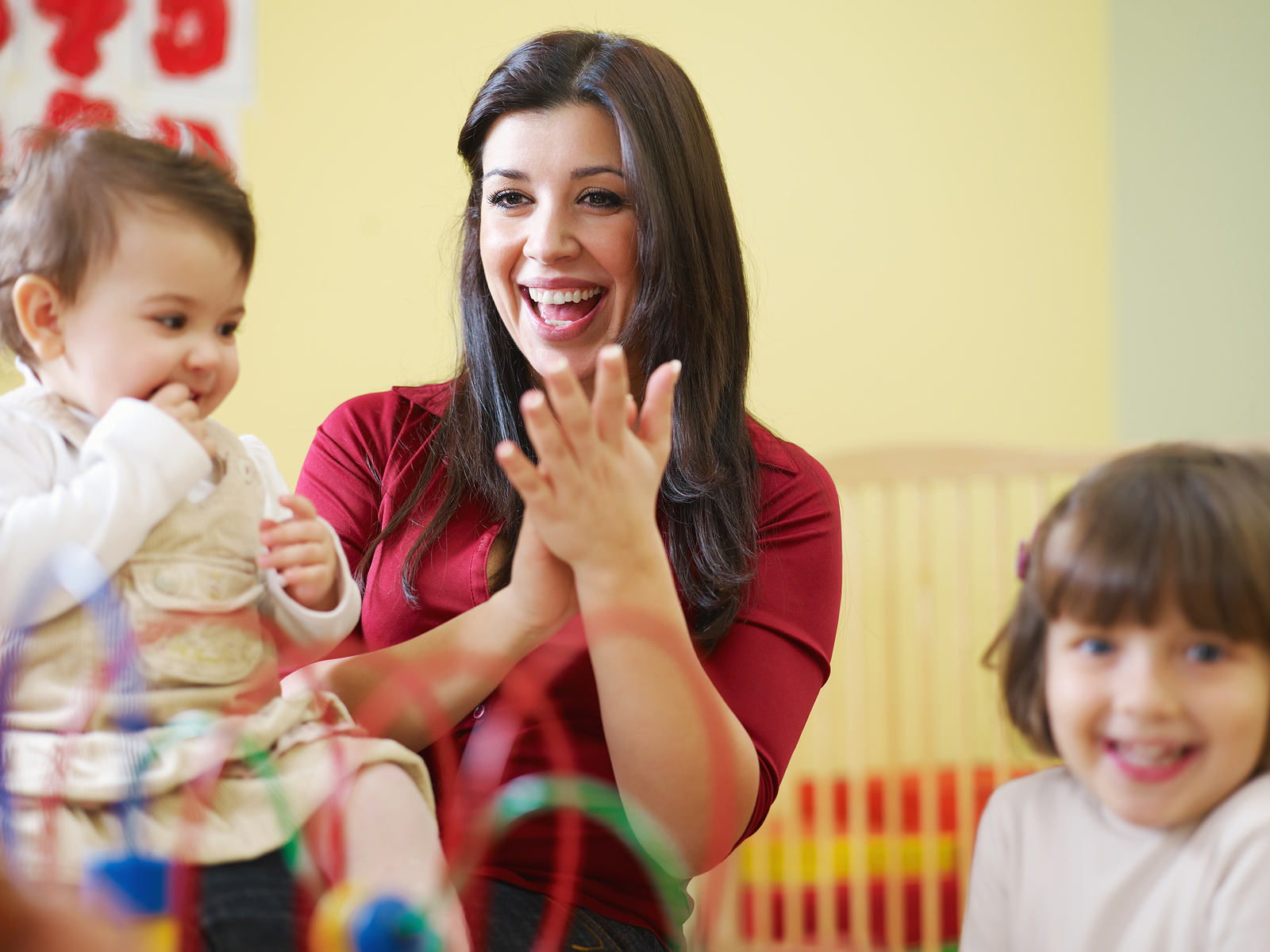




 Or if you are playing in the park, and another child is crying, you can label it for your child (e.g. “Look, she is crying. She feels sad”). You can also point out what his or her face is doing (e.g. “You’re feeling happy, because you are smiling and laughing”).
Or if you are playing in the park, and another child is crying, you can label it for your child (e.g. “Look, she is crying. She feels sad”). You can also point out what his or her face is doing (e.g. “You’re feeling happy, because you are smiling and laughing”).





